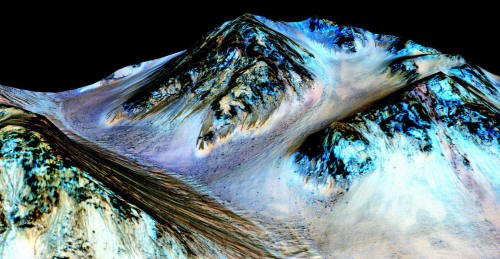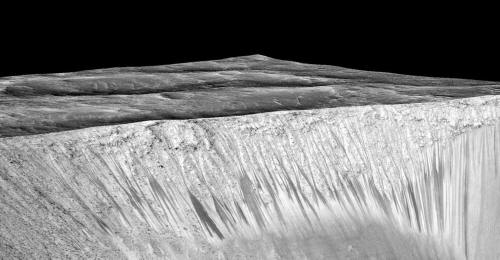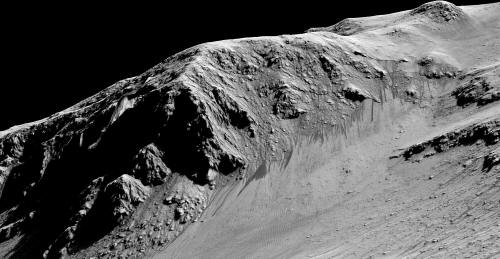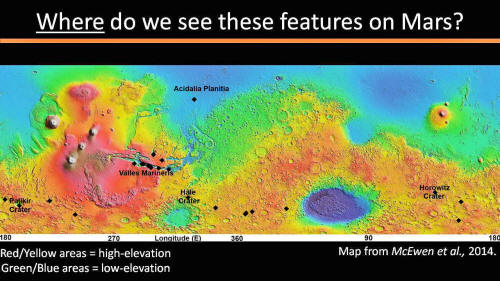|
from UniverseToday Website
flowing downhill on Mars are inferred to have been formed by contemporary flowing water. Recently, planetary scientists detected hydrated salts on these slopes at Hale crater, corroborating their original hypothesis that the streaks are indeed formed by liquid water. The blue color seen upslope of the dark streaks are thought not to be related to their formation, but instead are from the presence of the mineral pyroxene. The image is produced by draping an orthorectified (Infrared-Red-Blue/Green - IRB) false color image (ESP_030570_1440) on a Digital Terrain Model (DTM) of the same site produced by High Resolution Imaging Science Experiment (University of Arizona). Vertical exaggeration is 1.5.
Credits:
NASA/JPL/University of Arizona
NASA and Mars planetary scientists announced today (Sept. 28) that salty "liquid water flows intermittently" across multiple spots on the surface of today's Mars - trumpeting a major scientific discovery with far reaching implications regarding the search for life beyond Earth and bolstering the chances for the possible existence of present day Martian 'microbes.'
Utilizing spectroscopic measurements and imaging gathered by NASA's Mars Reconnaissance Orbiter (MRO), researchers found the first strong evidence confirming that briny water flows on the 'Red' Planet today along dark streaks moving downhill on crater slopes and mountain sides, during warmer seasons.
The evidence comes in the form of the detection of mysterious dark streaks, as long as 100 meters, showing signatures of hydrated salt minerals periodically flowing in liquid water down steep slopes on the Red Planet that "appear to ebb and flow over time."
The source of the water is likely from the shallow subsurface or possibly absorbed from the atmosphere.
Dark narrow streaks called recurring slope lineae emanating out of the walls of Garni crater on Mars. The dark streaks here are up to few hundred meters in length. They are hypothesized to be formed by flow of briny liquid water on Mars. The image is produced by draping an orthorectified (RED) image (ESP_031059_1685) on a Digital Terrain Model (DTM) of the same site produced by High Resolution Imaging Science Experiment (University of Arizona). Vertical exaggeration is 1.5. Credits: NASA/JPL/University of Arizona
Water is a key prerequisite for the formation and evolution of life as we know it. So the new finding significantly bolsters the chances that present day extant life 'could' exist on the Red Planet.
The data were gathered by and the conclusions are based on using two scientific instruments - the high resolution imaging spectrometer on MRO known as High Resolution Imaging Science Experiment (HiRISE), as well as MRO's mineral mapping Compact Reconnaissance Imaging Spectrometer for Mars (CRISM).
The mysterious dark streaks of downhill flows are known as recurring slope lineae (RSL).
They were first detected in 2010 at dozens of sites on the sun facing slopes of deep craters by Lujendra Ojha, then a University of Arizona undergraduate student.
The new finding is highly significant because until today's announcement, there was no strong evidence that liquid water could actually exist on the Martian surface because the atmospheric pressure was thought to be far too low - its less than one percent of Earth's.
The flow of water is occasional and not permanent, seasonally variable and dependent on having just the right mix of atmospheric, temperature and surface conditions with salt deposits on Mars.
Portions of Mars were covered with an ocean of water billions of years ago when the planet was far warmer and more hospitable to life. But it underwent a dramatic climate change some 3 billion years ago and lost most of that water.
The RSL with flowing water appear in at least three different locations on Mars - including Hale crater, Horowitz crater and Palikir crater - when temperatures are above minus 10 degrees Fahrenheit (minus 23 Celsius). They appear during warm seasons, fade in cooler seasons and disappear during colder times.
Pure surface water ice would simply sublimate and evaporate away as the temperature rises.
Mixing in surface salts lowers the melting point of ice, thereby allowing the water to potentially liquefy on Mars surface for a certain period of time rather than sublimating rapidly away.
Years of painstaking effort and laboratory work was required to verify and corroborate the finding of flowing liquid water.
The dark, narrow streaks flowing downhill on Mars at sites such as this portion of Horowitz Crater are inferred to be formed by seasonal flow of water on modern-day Mars. The streaks are roughly the length of a football field. These dark features on the slopes are called "recurring slope lineae" or RSL. The imaging and topographical information in this processed view come from the High Resolution Imaging Science Experiment (HiRISE) camera on NASA's Mars Reconnaissance Orbiter. Credit: NASA/JPL-Caltech/Univ. of Arizona
Along with the media announcement, the researchers published their findings today in a refereed scientific paper (Spectral Evidence for Hydrated Salts in Recurring Slope Lineae on Mars) in the Sept. 28 issue of Nature Geoscience.
The scientists,
Ojha said the chemical signatures from CRISM were most consistent with the detection of mixtures of magnesium perchlorate, magnesium chlorate and sodium perchlorate, based on lab experiments.
Perchlorates have previously been detected in Martian soil by two of NASA's surface missions - the Phoenix lander and the Curiosity rover. There is also some evidence that NASA's Viking missions in the 1970s measured signatures of these salts.
On Earth concentration of perchlorates are found in deserts.
This also marks the first time perchlorates have been identified from Mars orbit.
Locations of RSL features on Mars
NASA's overriding agency wide goal is to send humans on a 'Journey to Mars' in the 2030s.
So NASA astronaut Mark Kelly exclaimed that he was also super excited about the findings, from his perch serving as Commander aboard the International Space Station (ISS), where he is a member of the first ever "1 Year ISS Mission Crew" aimed at learning how the human body will adapt to the long term missions required to send astronauts to Mars and back.
The 'discovery' of liquid water on Mars could also be a boon to future astronauts who could use it as a natural resource to 'live off the land' for sustenance and to make rocket fuel.
Water Flowing on Present-Day Mars
|





